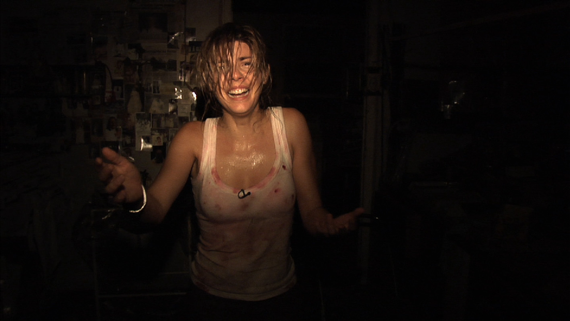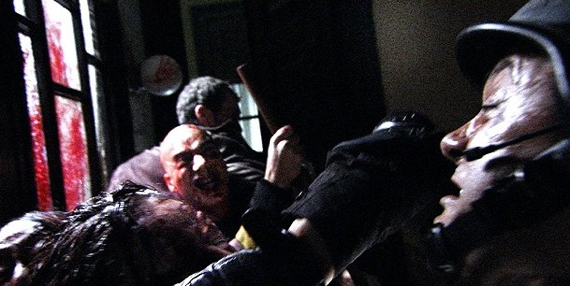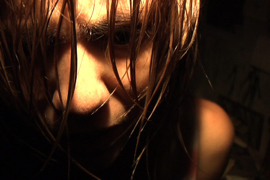Two years I went to the theater to see the spanish horror film “Rec” and (apart of jump from my seat many times) I realized about the very cool use of sound on the film. This year I saw Rec 2 and confirmed that, so I decide to ask some questions to the talented Oriol Tarragó, sound designer of both titles, and also interviewed by Jake some time ago, talking about another great horror-sound job: The Orphanage.
Designing Sound: How do you get involved with REC project? How long was the schedule in each film?
Oriol Tarragó: I met Jaume Balagueró and Paco Plaza working separately. I first met Jaume on “Films to Keep you Awake: To Let” and then Paco on “Films to Keep you Awake: Christmas Carol” after which they decided to direct “REC” together. I was on the project from the very beginning. We met for coffee one day and they told me the whole concept of “Length 90”, which was the original title. The script wasn’t finished yet and they didn’t have funding for the project, but I thought that it was an amazing idea for a movie and we all did what we could to make it happen.
“REC 1” had a very small budget and we had to work hard for 10 weeks of editing and 2 weeks of final mix.
“REC 2” had a little bit bigger budget, we did the sound design for 12 weeks and we had 3 weeks for the final mix, but the sequel was a lot more complex so we had to work very, very hard to finish on time.
DS: In an interview with Jaume Balagueró and Paco Plaza (Directors), they explained how important sound was in both Rec 1 and 2. What was the importance in sound they conveyed to you?
OT: Besides the fact that neither “REC 1” nor “REC 2” have any music, the sound styles stem from 2 different conceptions in film. In “REC1” we had to make people believe that they were watching a real documentary. So we were very concerned about making the sound design with real sounds. We had clean production sound, which we made imperfect to mimic the documentary style. We used lots of post-production sound effects, but we tried to make the audience feel that the film was found footage. I think the horrific thing about “REC 1” is that people believe that it is a real situation. I think sound had something to do with that.
On “REC 2” we still had the documentary style. However, being a sequel the audience knows they’re going to see a zombie movie and are aware that it is a fake documentary. So we were not so concerned about reality and we had more freedom for non-diegetic sounds and sound design. We were more focused on making demons and possessions. Suddenly “REC 2” became something spiritual, something more fantastic than just a virus as in “REC 1”.
DS: Since “REC 2” is all “in-camera” and therefor played toward realism, how did your team play with POV’s sounds to convey that reality(sound of camera being dropped, et.c) and what did you embellish to add tension or drama?
OT: In “REC1” we just had one POV, the local TV camera. So we recorded in a studio lots of mic feeds, mic drops, and we recorded handling sounds to sweeten the production. We had one made by a mic without a windscreen that we swung making the air blow and distort the capsule, producing very low frequency that we used as an atmosphere we used to add tension in a few scenes. Even though “REC 1” was mixed in 5.1 the whole mix is quite central (mono). We wanted to convey the idea that there was just one mic over the camera capturing all the sound in the film. So we had we’re re-creating the on-axis or off-axis mic effects by using EQ and Reverbs.
For “REC2” we had 4 different POVs: the main police camera, the helmet cameras, the kids’ camera, and the local TV camera from “REC 1” found at the end of “REC 2”. That made things more fun for us, because every camera had to have its own POV, handling, and recording sounds.
We made the police camera sound as if it had a 5.1 mic on it. We panned all the sounds around the theater to make people feel that it was 3D sound and the center is at the audience. The helmet cameras have this filtered radio futz. The kids’ camera is more stereo and has the common switch-on and switch-off sounds of a standard amateur mic.
DS: Another great sound element in these films are off-screen activities. There’re many scenes where sound is exclusively telling the story. How we’re these off-screen moments designed?
OT: This is my favorite part of working on these films, because it is pure sound design. There is no the picture limiting your imagination… You are free. For me there has to be a reason behind every sound in a movie. I know the audience doesn’t think about it but, if I can explain everything that is in the speakers the audience will believe that that action is really taking place out of frame. So what I do is really build in my mind what we have to hear and then go record it.
DS: There’re really dark moments, with sound effects treated as musical elements, such as the final scene on REC 2 when the possessed journalist girl kills the priest. You hear a really dark ambience, sometimes melodic, but wait! The film doesn’t have any music! What was the theory behind this sound design, knowing that you don’t have support of music to help motivate the audience’s emotions?
OT: LOL! Exactly right! The most musical part of both REC movies is the end of “REC 2”. In that scene, I really missed music I must admit! So one day I was at my father’s house where he has a real old gramophone. He bought it out because we have a collection of phonograph records from my grandfather that we hadn’t played before. Listening to the collection with him we found 2 records of recorded stories, namely “Sleeping Beauty” and “Little Red Hood”. One was in Catalan, a language that is only spoken in Catalonia (Barcelona area); when we played it, it was very bizarre. Hearing the voice of a woman recorded on that old record was something that frightened me and I know no one would understand what she said. I recorded it, added some reverb, and got this very foggy and strange atmosphere that sounds like the voice from hell. Later I mixed in another atmophere created by synthesizer.
In other scenes like the one where the priest is exposed, it is very obvious that we used 2 different atmospheres made by synthesizer and a keyboard to get this soft score feel.
Since every room or space had its own and unique sound character, I had several different kinds of atmospheres and ambiences running throughout the movie. I divided all the ambiences that I did into 2 big groups: sounds and ambiences from outside the building and sounds and ambiences from inside. So sounds from inside the building are air currents, metal movements, water drops, pipes, bizarre building sounds, very low pulse from helicopters. All tailored toward the dark, mysterious, suspense, tension, and horror side. Sounds from outside are sirens, police loudspeakers, non-filtered helicopters, distant voices from the crowd outside, i.e. civilization, the real word. So the sounds from inside and atmospheres made by synthesizer played as score, whereas the sounds from outside I used for anticlimax scenes or to mellow the out the mood. With this idea of global sound design, I could work as if I had had score composed for the film. Increasing or decreasing the drama… At least that was what I aimed to do.
DS: What special sounds did you record for the both films?
OT: We had different record sessions of screaming and yelling. We also recorded radio voces, alert voices, speakers, radios, intercoms, etc. On location we recorded ambiences of the crowd screaming, clapping, etc. Ambiences of the city of Barcelona. We also recorded lots of sounds of camera handling, mic distortions… Sounds of junk, metal, chains, bizarre sounds that where difficult to identify…
We also recorded lots of footsteps in a natural location, doors being slammed, etc. And we recorded an impulse response for ALTIVERB to get the real reverb of the location building’s staircase.
DS: Let’s talk about the zombies vocals. There’re many different kinds of zombies in the film and each sounded unique. How did you approach the sound design for them?
OT: That was probably the hardest work in the film, as it was very annoying to spend a lot of time editing screams.
We realized that by using the human screams we recorded for “REC 1”, the zombies weren’t scary enough. So we decided to mix them with a bunch of animals and synthetic sounds. What we did was edit the human screams in sync with the lips and then we used software to modulate the animal to have both textures, as if we’re using a vocoder.
DS: How much production dialog was salvaged from shoot and how much ADR had to be shot? What was the theory behind the dialog in general since in the “reality” of the film not everyone was mic’ed?
OT: We mic’ed all the actors with lapel mics, in addition we had a boom and the camera had a mic recording on top all the times. Even with all that coverage we had to do a lot of ADR, but it wasn’t always for technical reasons. In “REC 1” and “REC 2” there is a lot of actor improvisation as the takes were very long. So there was a lot of inter-cutting that made us build a puzzle of dialog from different takes. We also had to rewrite some scenes to correct text mistakes and make sure everything was understandable.
In scenes with the demonic talking how much was of that performance vs. processing?
Performance was very important. We needed the intention, especially Tito’s exorcism. He did a great job. He did this very deep breath and with the processing we got amazing results. Although we did a lot of processing, we always wanted to keep the actor’s voice inside the demon. You can tell the voice is not always the same, the process is more obvious or less depending on the moment… As if the real person was fighting to break out… Or something like that
DS: I love the way you dealt with the final scenes in REC 1. The claustrophobic nature of only being able to see as far as the nightvision on the Mederios girl’s camera. The sound is really accentuated that feeling. What was your approach for that kind of scene?
OT: The penthouse that should be a shelter is the worst place in the building to be. During the scene, after that long black sequence with all the door bangs and dialog, we wanted to have the audience discover a new world when the torch on the camera lit the room… Very trickily when they turn the light on, the ambience changes radically, as if we were going into a new dimension. We played the door bangs so loudly that you couldn’t notice the ambiences shift. When they switch on the light the ambience appears, like the stink of the room.
Afterwards when the torch gets broken by the kid on the ceiling, we cut the ambiences again, allowing for a deep silence. The horrific thing about that freezing silence is that we suddenly start hearing the steps of someone coming closer from the other room. I was frightened in the edit room while I was cutting it. Jaume Balagueró and Paco Plaza made one of the scariest scenes I have ever worked on or seen. I guess that’s why I didn’t have to add anything to it, the silence was perfect.
DS: What was the most challenging sound/scene you found on each film? And what’s your favorite?
OT: Honestly, every time I finished a scene I thought it had been the most difficult one in the film, but the next one was always worse. The Medeiros scene and attack had to be the scariest scene in the whole film and at the end of “REC 2”, when the Medeiros girl shows up again, I felt the same pressure. All the fans wanted to see the Medeiros girl again and get frightened so it was a great payoff.
My favorite scene though is the end of “REC 1” at the penthouse. It is pure suspense and horror.





Nice article! Having grown up in Spain I have seen Rec (haven’t seen Rec2 though) and I am glad to see an article about a sound designer on a movie like this. It must have been a weird movie to work on where as opposed to making things sound clean and undisturbing they had to purposefully make it sound more raw, dirty and “live”. Cool article indeed and nice to see some less “known” sound designers featured here :)
great interview, i love both films.
gracias Miguel y Oriol! ;)